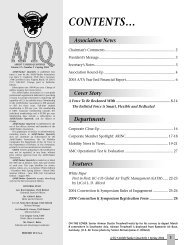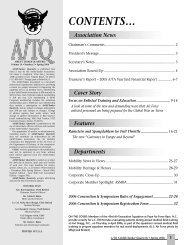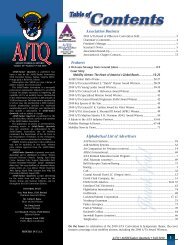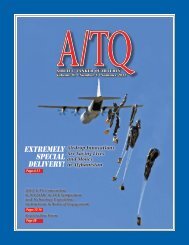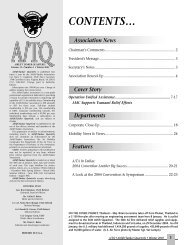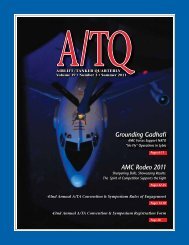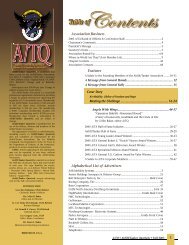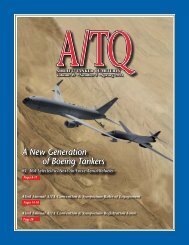1) ATQ Fall 2003 for pdf - Airlift/Tanker Association
1) ATQ Fall 2003 for pdf - Airlift/Tanker Association
1) ATQ Fall 2003 for pdf - Airlift/Tanker Association
You also want an ePaper? Increase the reach of your titles
YUMPU automatically turns print PDFs into web optimized ePapers that Google loves.
From Battlefields to Airfields –<br />
The Role of AMC Assessment Teams in Operation Iraqi Freedom<br />
by Colonel Gregory P. Cook<br />
Introduction<br />
The United States Air Force has evolved into a truly expeditionary<br />
<strong>for</strong>ce, as evidenced by continuing operations in support of the Global<br />
War on Terrorism. In the time period since the terrorist attacks of<br />
September 11 th 2001, a number of Air Force <strong>for</strong>ward operating bases<br />
were rapidly established around and inside combat zones, with Air Force<br />
units operating side by side with ground combat <strong>for</strong>ces in austere, and<br />
often hostile, conditions. From Afghanistan to Iraq and throughout the<br />
United States Central Command (USCENTCOM) Area of Responsibility<br />
(AOR), these <strong>for</strong>ward bases have proven crucial to allied victories in<br />
both Operation Enduring Freedom (OEF) and Operation Iraqi Freedom<br />
(OIF). The role of Air Mobility Command<br />
(AMC) has been central to these ef<strong>for</strong>ts,<br />
and the command has thus been given<br />
primary responsibility <strong>for</strong> establishing<br />
expeditionary air bases to support these<br />
types of operations in the future. As a<br />
result, new operational concepts and<br />
missions are being developed to meet<br />
this requirement, building on existing air<br />
mobility capabilities while incorporating<br />
the many lessons learned along the way.<br />
At the root of AMC’s new role is the<br />
realization that substantial airlift is<br />
required to establish <strong>for</strong>ward operating<br />
locations or to enable the rapid<br />
introduction of combat <strong>for</strong>ces and<br />
support capabilities deep into hostile or<br />
denied territory, especially in landlocked<br />
countries like Afghanistan. The most<br />
significant uncertainties and challenges<br />
faced by Air Force units revolved around<br />
the need to bridge the gap between airfield seizure <strong>for</strong>ces and airbase<br />
opening <strong>for</strong>ces, essentially to trans<strong>for</strong>m what had been a “battlefield”<br />
into an airfield. Yet Joint doctrine and operating procedures had not<br />
been fully developed to achieve these objectives, and thus the Air Force<br />
experienced some difficulties opening airfields in Afghanistan as a result.<br />
Ground <strong>for</strong>ce commanders had different priorities and perceptions than<br />
their Air Force counterparts, and it took longer than expected to ensure a<br />
safe operating environment <strong>for</strong> air mobility aircraft both in the air and on<br />
the ground be<strong>for</strong>e airlift operations could commence. What was missing<br />
from these base openings was the influence of an airman on the initial<br />
activities at the new airfield. Ground commanders often do not share an<br />
airman’s sensitivity to the characteristics of mobility aircraft that make<br />
them highly vulnerable - larger, slower and less maneuverable than fighter<br />
aircraft, with predictable tactics <strong>for</strong> arrivals and departures.<br />
Initially, the concept of a Global Mobility Task Force (GMTF) was<br />
developed to address these shortcomings and to prescribe the types of<br />
capabilities needed and the order in which they would be introduced to<br />
realize base opening objectives. The first and most critical requirement<br />
was the ability to rapidly assess the physical characteristics of a captured<br />
airfield and the surrounding operational environment to determine its<br />
capability to safely and effectively support air operations. To address<br />
this need, AMC worked with its two Air Mobility Operations Groups<br />
(AMOGs) at McGuire and Travis Air Force Bases to create four new, rapidly<br />
deployable, airfield assessment teams. These teams were to be manned,<br />
equipped and trained to work alongside seizure <strong>for</strong>ces to assess and shape<br />
the operational environment of an airfield, initiate airlift operations<br />
and then lead the airbase opening process until follow-on <strong>for</strong>ces and<br />
leadership arrive on scene. As the likelihood of war in Iraq increased,<br />
concept development turned quickly into real-world deployment and<br />
execution of the assessment team mission. Their successful employment<br />
during Operation Iraqi Freedom became history in the making, and<br />
ushered in a new era in air mobility and USAF operations.<br />
26 A/TQ •<strong>Airlift</strong>/<strong>Tanker</strong> Quarterly • <strong>Fall</strong> <strong>2003</strong><br />
GAT Cook loads their equipment onto MH-53s at Bashur <strong>for</strong><br />
their final leg to Kirkuk, Iraq. Col. Cook is in the <strong>for</strong>eground.<br />
Assessment Team Concept of Operations<br />
The objective of the assessment team is to conduct rapid airfield<br />
assessment and basic preparations <strong>for</strong> follow-on <strong>for</strong>ces. To accomplish<br />
their mission, a small, highly mobile, self-sufficient team would rapidly<br />
deploy and insert with any Department of Defense ground combat or<br />
airfield seizure <strong>for</strong>ce. The assessment team would survey the airfield, assess<br />
the operational environment, and then report their findings directly back<br />
to pre-identified decision makers via secure communications. This report<br />
would be the basis <strong>for</strong> development and sequencing of follow-on <strong>for</strong>ces<br />
required to execute the base opening.<br />
The teams were to organize as a deployable package that is light, lean,<br />
quick to deploy and employ, and easy<br />
to sustain, re-deploy, and reconstitute.<br />
For AMC, the teams would provide the<br />
command with a senior officer’s “eyes on,”<br />
first-person assessment of the operational<br />
environment. In a Joint <strong>for</strong>ce operating<br />
scenario, they would coordinate AMC and<br />
USAF needs and requirements with ground<br />
<strong>for</strong>ce commanders. In combat conditions,<br />
they would bridge the gap between airfield<br />
seizure and base opening <strong>for</strong>ces, reduce<br />
the time <strong>for</strong> the start of airlift operations,<br />
initiate airfield opening actions and receive<br />
initial deploying <strong>for</strong>ces.<br />
Assessment Focus Areas<br />
Initially, the assessment teams would<br />
gather data about the airfield, including<br />
runway, taxiway and ramp dimensions and<br />
conditions. They would also document<br />
obstacles that could interfere with aircraft<br />
operations, evaluate pavements <strong>for</strong> their strength, weight-bearing capacity<br />
and expected longevity, and identify types and conditions of airfield<br />
lighting and markings. They would analyze airfield operations facilities<br />
that could provide air traffic control, communications, and weather<br />
capabilities, and determine the availability of transportation, logistics, and<br />
base support assets. Finally, they would review security and <strong>for</strong>ce protection<br />
requirements, conduct threat assessments, and determine the friendly order<br />
of battle and its capability to respond to threats.<br />
What do We Call Them<br />
Not surprisingly, what to call the teams became a point of significant<br />
discussion and confusion, as the name changed with virtually every new<br />
draft CONOPS or briefing. First they were called a Base Assessment Team<br />
or BAT, then a Contingency Base Assessment Team or C-BAT. Next came<br />
the Global Mobility Task Force Assessment Team (GMTF AT), which was<br />
shortened to Global Mobility Assessment Team (GMAT). The name that<br />
finally stuck, as the result of common usage, was Global Assessment Team,<br />
or GAT. The one common denominator in all these descriptors was that<br />
they were an Assessment Team (AT), and so the team commanders simply<br />
used that term when discussing their mission. At one point during the war,<br />
a media report probably coined the most descriptive term, that of a Global<br />
Airfield Assessment Team (GAAT), which truly captured the essence of their<br />
mission. They are globally oriented and capable, their mission is airfield<br />
assessment, and they are a small, specialized team of experts.<br />
Assessment Team Makeup<br />
AMC determined that the assessment team commander must be a rated<br />
colonel with extensive air mobility expertise. His role was to act as the<br />
primary point of contact <strong>for</strong> theater and command decision makers and<br />
serve as the principal liaison between his team and the ground and/or host<br />
nation <strong>for</strong>ces. Since the assessment team commander was expected to be the<br />
senior Air Force officer on the scene, he would have much greater influence,




